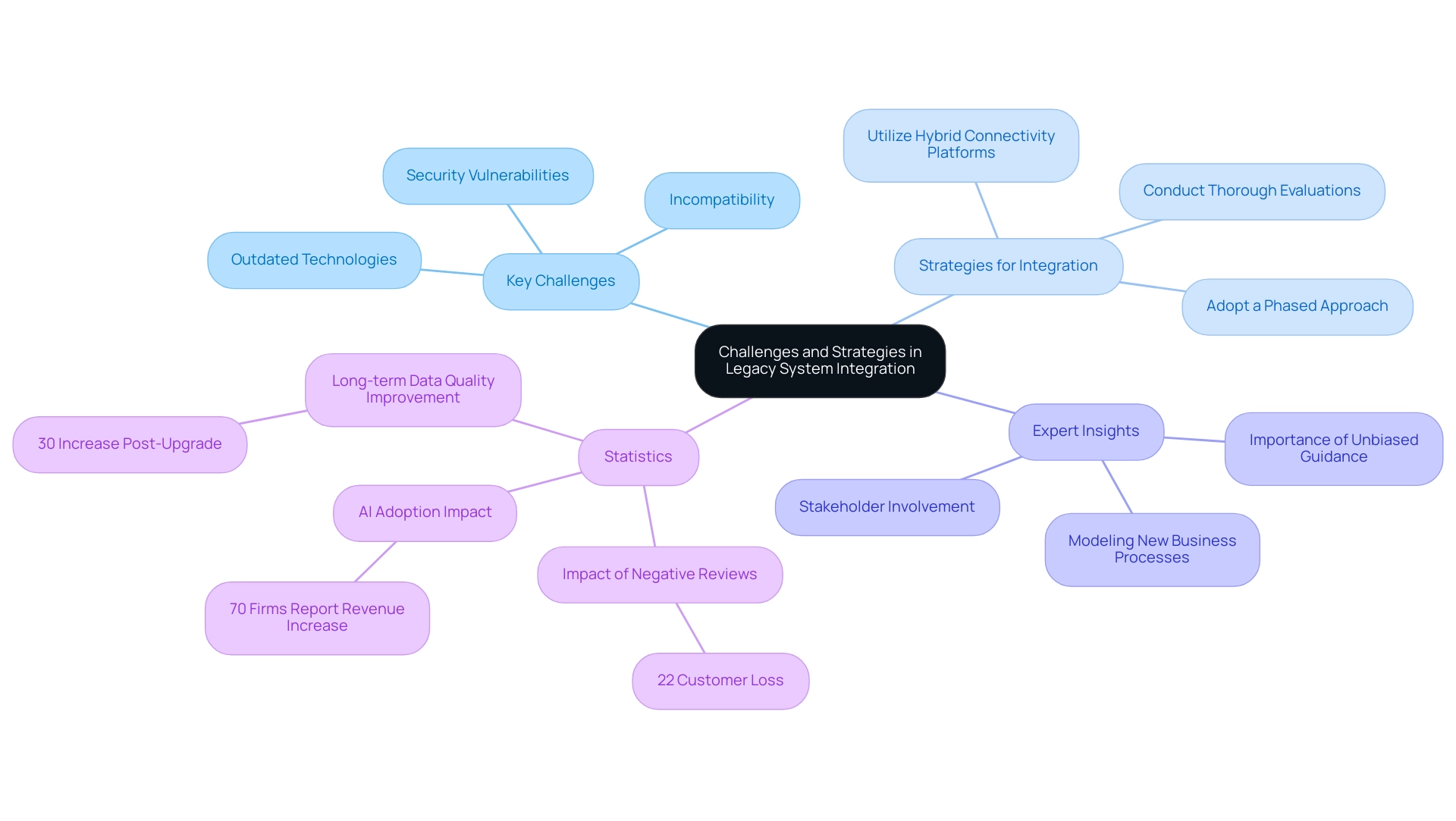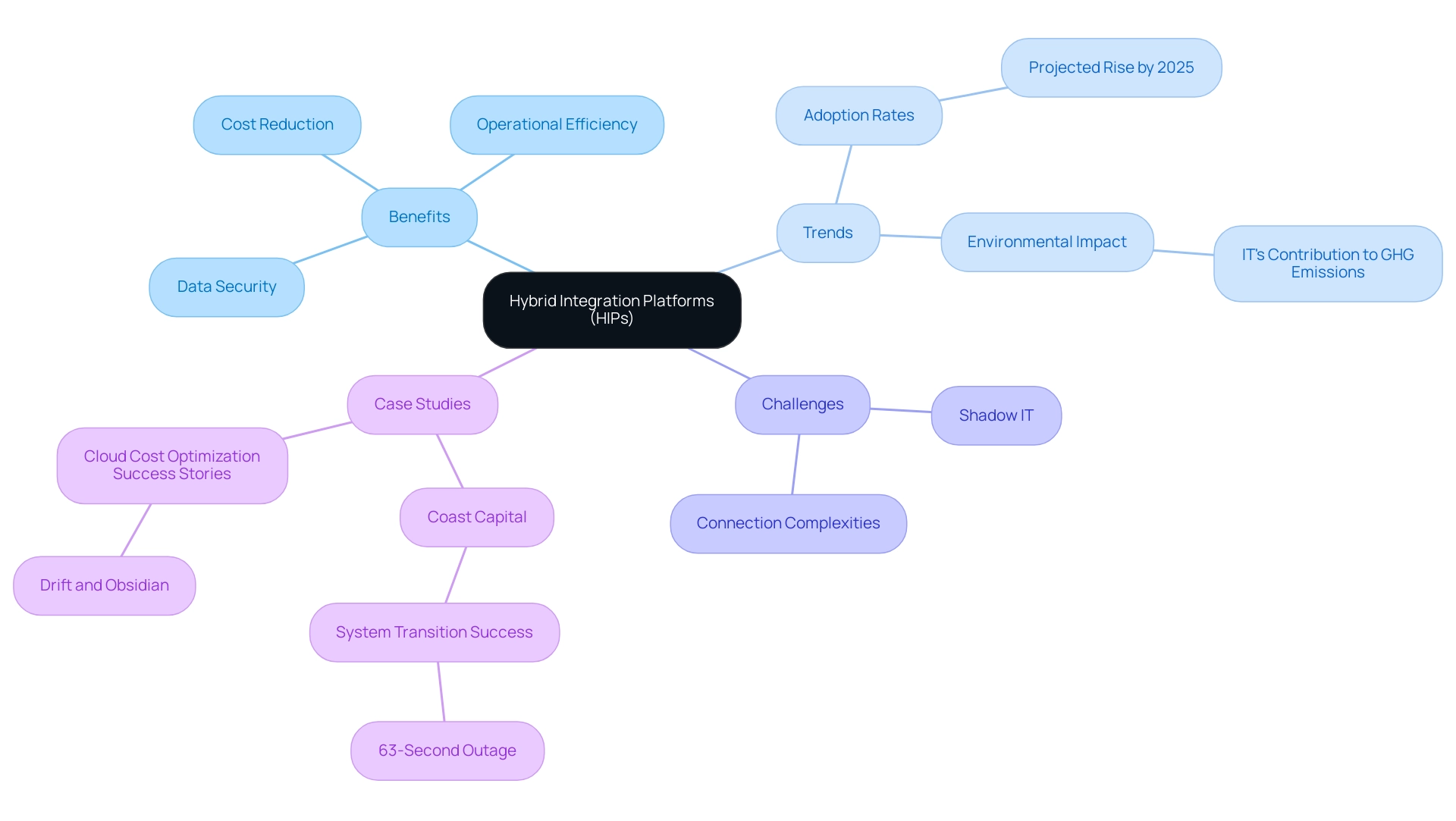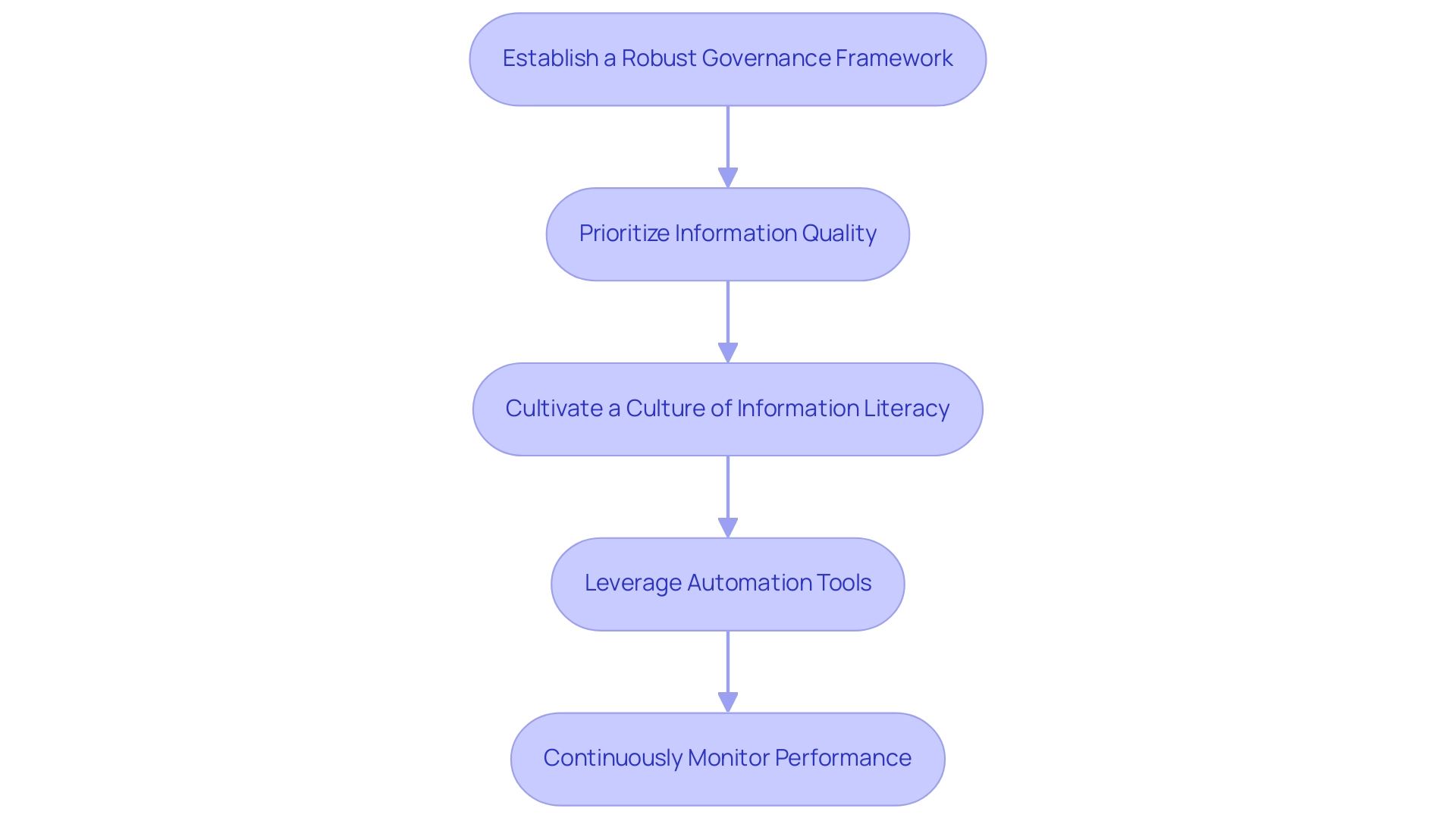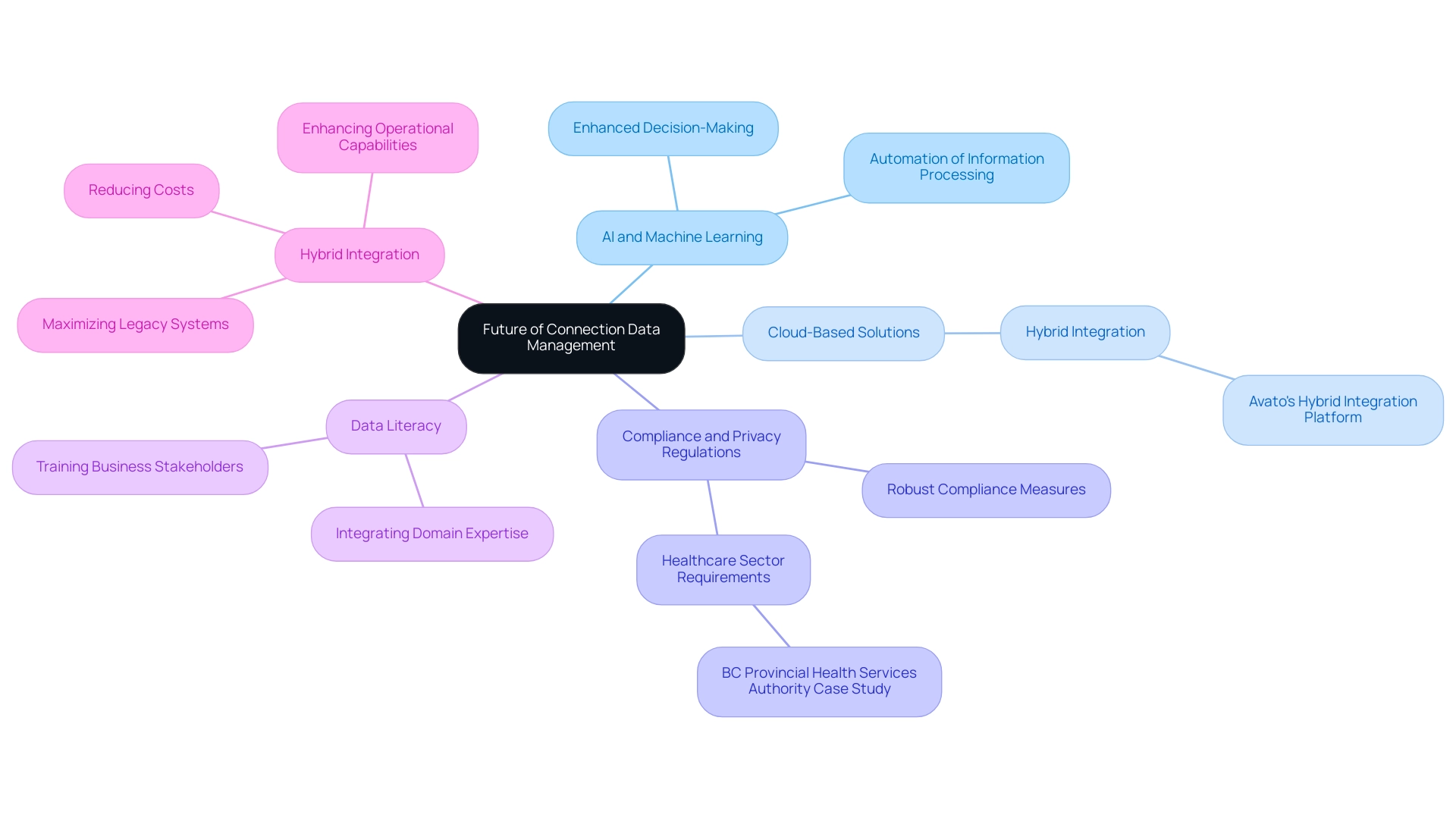Overview
The article presents essential insights and strategies for IT managers aiming to master connection data management. This management is critical for enhancing operational efficiency and strategic decision-making. But how can organizations effectively navigate this complex landscape? By establishing robust governance frameworks, prioritizing information quality, and leveraging hybrid integration platforms, organizations can significantly enhance data accessibility, security, and compliance. These best practices collectively position organizations for sustained success in a rapidly evolving digital landscape. Are you ready to transform your data management approach and secure your organization’s future?
Introduction
In the rapidly evolving landscape of information technology, effective connection data management has become a critical component for organizational success. This systematic approach not only ensures seamless data flow between diverse systems but also safeguards accessibility, accuracy, and security. As IT managers face the complexities of modern data environments, mastering connection data management is essential for optimizing operational efficiency and leveraging data for strategic decision-making. Furthermore, with the rise of hybrid integration platforms like Avato, organizations are empowered to streamline their integration processes and enhance responsiveness to market demands. This article delves into the best practices, challenges, and innovations in connection data management, providing valuable insights for IT professionals who aim to navigate this intricate domain and drive their organizations toward sustained success.
Understanding Connection Data Management: A Key Component for IT Success
Connection information oversight represents a systematic approach to orchestrating information flows across disparate systems, ensuring that information remains accessible, accurate, and secure. For IT managers, mastering this discipline is not merely beneficial; it is essential, as it significantly influences operational efficiency and the capacity to leverage information for strategic decision-making. Effective connection information oversight encompasses a comprehensive understanding of information sources, the formulation of robust protocols for information exchange, and the establishment of governance frameworks that uphold information integrity.
Avato’s dedicated hybrid unification platform empowers organizations to enhance their agility and responsiveness to evolving market demands, ultimately fostering business success. By streamlining intricate integrations and augmenting the value of legacy systems, the company enables businesses to access information and systems in weeks, not months. This capability is crucial for IT managers aiming to boost operational efficiency, as statistics reveal that organizations with efficient information handling practices experience a 20% increase in operational effectiveness.
Case studies from industry leaders provide concrete evidence of the advantages of effective connection data oversight. For example, Gustavo Estrada from BC Provincial Health Services Authority remarked that Avato has simplified complex projects, delivering results within the desired time frames and budget constraints. Such testimonials underscore the platform’s ability to streamline integration processes, reinforcing its reputation as a reliable partner for organizations striving to achieve their integration goals swiftly and efficiently.
Looking ahead to 2025, best practices for managing connection data will involve adopting a mesh approach, which fosters decentralized ownership and promotes self-service capabilities among teams. This transition not only enhances collaboration but also empowers teams to respond more effectively to business needs. Key roles within these teams, such as Data Architects and Data Engineers, are pivotal in ensuring that information flows seamlessly across systems.
Furthermore, effective Enterprise Information Management (EIM) practices are indispensable for leveraging information as a valuable asset in the digital era. IT managers should focus on developing strategies that prioritize information quality, security, and accessibility. By doing so, they can lay a solid foundation for data-driven decision-making, ultimately leading to improved operational outcomes and a competitive edge in their respective industries.
Integrating Legacy Systems: Overcoming Challenges in Data Management
Integrating legacy systems presents a myriad of challenges: incompatibility, outdated technologies, and security vulnerabilities. IT managers face increasing pressure to navigate these obstacles effectively, ensuring a seamless transition to modern systems. A notable statistic emphasizes that one negative review can discourage up to 22% of potential customers, underscoring the importance of maintaining operational integrity during implementation processes.
To tackle these obstacles, essential strategies involve:
- Conducting thorough evaluations of current systems to pinpoint vital connection data
- Utilizing a hybrid connectivity platform, enabling interaction between legacy and contemporary applications
Organizations utilizing cloud-based platforms have reported improved scalability in their connection data, allowing them to respond swiftly to market changes and varying workloads. This adaptability not only enhances resource allocation flexibility but also reduces infrastructure costs, ultimately leading to better customer satisfaction.
As Gustavo Estrada pointed out, “The platform has streamlined intricate projects and provided outcomes within preferred timelines and financial limits,” emphasizing its efficacy in addressing connectivity challenges.
The transformative impact of AI adoption in the financial sector is evident, with nearly 70% of firms reporting at least a 5% revenue increase attributable to AI implementations. Avato’s hybrid unification platform plays a crucial role in this shift, enabling financial institutions to enhance operational visibility and issue resolution, thereby driving efficiency and cost reductions. Adopting a phased approach to unification is another effective strategy that helps mitigate risks and minimize disruptions.
By breaking down the combining process into manageable stages, organizations can ensure that each phase is thoroughly tested and optimized before progressing to the next. This method not only enhances system reliability but also supports ongoing data performance through strong monitoring practices linked to Avato’s capabilities, resulting in a 30% increase in long-term connection data quality post-upgrade.
Expert insights highlight the importance of obtaining unbiased guidance concerning end-of-life applications, greatly influencing the success of implementation efforts. IT professionals note that addressing these challenges head-on allows organizations to unlock the full potential of their legacy systems while paving the way for future innovations. Furthermore, involving stakeholders early in the process and modeling new business processes are vital actions that can lead to successful outcomes.
By implementing these strategies, IT managers can navigate the complexities of legacy system integration and position their organizations for sustained success.

Navigating Compliance and Security: Priorities for Banking IT Managers
For IT managers in the banking sector, navigating compliance and security is paramount. Regulatory frameworks such as GDPR and PCI DSS impose stringent requirements on information handling and protection, necessitating a proactive approach to governance. IT administrators must establish comprehensive information governance policies, conduct regular audits, and ensure that all information handling practices align with these regulations.
Advanced security measures, including encryption and access controls, are essential for safeguarding sensitive customer information. The urgency for strong security frameworks is underscored by alarming statistics, such as Cam4 holding the record for the largest breach of all time with over 10 billion compromised accounts. Furthermore, over half of contractors are struggling to implement CMMC compliance requirements, highlighting the pressing challenges faced by banking IT managers in maintaining compliance.
By prioritizing compliance and security, banking IT managers can not only mitigate risks but also foster trust with customers and stakeholders, ultimately minimizing the potential for costly breaches and penalties.
Case studies, such as those from Bright Defense Compliance Solutions, illustrate the effectiveness of continuous compliance services in helping organizations meet various compliance frameworks, including CMMC. These solutions enable organizations to achieve compliance certification while continuously enhancing their security programs to adapt to evolving threats and standards.
Moreover, expert opinions emphasize the importance of staying updated on compliance developments, with 77% of compliance professionals acknowledging the significance of ESG advancements. Additionally, three out of five corporate risk and compliance professionals feel confident about their ability to address compliance risks, indicating a positive outlook in the industry.
As the landscape of regulatory requirements changes, banking IT managers must stay alert and flexible, ensuring their information handling practices not only comply with current regulations but also foresee future challenges.
The Role of Hybrid Integration Platforms in Streamlining Data Management
Hybrid connection platforms (Hips) are essential for enhancing information management, ensuring seamless connectivity and managing connection data between on-premises and cloud-based systems. The Hybrid Integration Platform, in particular, maximizes the value of legacy systems while simplifying complex integrations and significantly reducing costs. These platforms enable real-time connection data exchange, automate workflows, and establish centralized governance, collectively empowering organizations to manage their resources with greater efficiency.
By 2025, the adoption of Hips is anticipated to rise significantly, driven by the necessity for organizations to optimize operations and enhance information visibility—a requirement that the company is well-equipped to fulfill with its robust offerings.
IT managers utilizing Avato’s HIP can effectively reduce connection complexities, particularly advantageous in sectors like banking where information sensitivity is paramount. A notable trend reveals that 46% of European companies store all their information in the cloud, with a substantial portion classified as sensitive. However, only 54% of this sensitive connection data is encrypted, underscoring the critical need for robust unification solutions that prioritize security alongside accessibility.
Moreover, with IT expected to account for 8% of global GHG emissions by 2025, the environmental consequences of information handling and integration cannot be overlooked.
Successful implementations of HIP in banking have demonstrated its capacity to significantly enhance the management of connection data. Organizations that have adopted this platform report improved operational efficiency, with many achieving considerable cost savings through optimized information workflows. For instance, the collaboration with Coast Capital illustrated how the platform facilitated major system transitions with minimal downtime, achieving a mere 63-second outage during a critical switch, underscoring its reliability and effectiveness in the financial sector.
The benefits of utilizing HIP extend beyond mere cost reductions; they also facilitate scalability and effective management of connection data, enabling organizations to adapt to evolving business requirements without compromising information integrity or security. Furthermore, addressing the challenges posed by shadow IT is crucial, as unregulated information handling practices can lead to significant risks. Expert insights indicate that Hips are pivotal in navigating these complexities, empowering IT managers to maintain a competitive edge.
As Gustavo Estrada, a client, remarked, “The company has simplified complex projects and delivered results within desired time frames and budget limitations,” highlighting the effectiveness of HIPs in achieving unification goals swiftly and efficiently.
In summary, hybrid integration platforms such as Avato’s are not merely tools for information handling; they are strategic assets that enhance operational capabilities, mitigate risks linked to digital transformation, and ensure that organizations can innovate without compromise.

Implementing Effective Connection Data Management Strategies: Best Practices for IT Managers
To implement effective connection information handling strategies, IT managers must adopt the following best practices:
-
Establish a Robust Governance Framework: A well-defined framework is crucial for outlining roles, responsibilities, and processes related to information management. This framework facilitates accountability and ensures compliance with regulatory requirements, particularly in sectors like banking and healthcare. Avato’s reliable technology stack supports this adaptability, enabling businesses to respond to changing demands.
-
Prioritize Information Quality: Implementing validation checks and conducting regular audits are essential to maintain accuracy and consistency. High-quality information is foundational for informed decision-making and operational efficiency.
-
Cultivate a Culture of Information Literacy: Empowering employees with the knowledge and skills to understand and utilize information effectively fosters a knowledge-driven culture. This initiative enhances collaboration and innovation across departments.
-
Leverage Automation Tools: Utilizing automation tools streamlines integration processes, significantly reducing manual errors and enhancing efficiency. Automation accelerates workflows and allows IT teams to focus on strategic initiatives. As noted by Gustavo Estrada, Avato streamlines intricate projects, providing outcomes within specified time limits and budget restrictions—demonstrating the efficiency of automation in information management.
-
Continuously Monitor Performance: Regularly assessing performance enables IT managers to identify bottlenecks and make necessary adjustments to optimize workflows. This proactive method guarantees that information oversight strategies align with organizational objectives. The importance of continuous monitoring is underscored by the need for robust analytics capabilities that utilize connection data to optimize operations, improve customer experiences, and identify new opportunities for innovation. Organizations with efficient information handling systems can reduce redundancy, optimize sharing, and protect against unauthorized access.
By applying these best practices, IT leaders can significantly enhance their information oversight abilities, ensuring that their organizations remain agile and competitive in a constantly changing environment. The effectiveness of these strategies is further supported by insights from industry experts, emphasizing that a robust information governance framework is not merely a regulatory necessity but a strategic advantage that can drive innovation and operational excellence.

Real-Time Monitoring and Alerts: Ensuring Optimal Performance in Data Management
Real-time monitoring and alerts are essential for effective information management, especially in complex environments dominated by legacy systems. By leveraging advanced monitoring tools, such as those offered by a hybrid integration platform, IT managers can continuously track system performance and connection data. This capability allows for the swift identification of potential issues, ensuring a seamless information flow across interconnected systems. Avato’s features include AI-enabled anomaly detection, enhancing the ability to respond proactively to emerging challenges.
Configurable alerts act as a vital early warning system, promptly notifying relevant personnel of anomalies and enabling swift action to mitigate risks before they escalate.
The importance of real-time monitoring is underscored by the projection that by 2024, over 75% of organizations are expected to invest in next-generation analytical tools that deliver real-time insights, thereby facilitating smarter decision-making. This trend highlights the growing recognition of the need for prompt information processing capabilities, particularly as real-time information presents unique challenges compared to traditional batch processing, necessitating specific management considerations for connection data.
Incorporating analytics to evaluate historical performance data not only aids in identifying trends but also cultivates a culture of continuous improvement. For example, a major airline that embraced real-time information analysis to enhance its flight operations achieved an impressive 25% reduction in delays, significantly improving operational metrics and fostering customer loyalty. This case exemplifies how real-time insights can yield tangible benefits—a critical factor for banking IT managers confronting similar operational challenges.
Moreover, expert perspectives emphasize that alerts are more than mere notifications; they embody essential connection data within a robust information handling strategy. IT professionals understand that effective alert systems can significantly enhance performance in connection data management, ensuring organizations remain agile and responsive to evolving demands. By prioritizing real-time monitoring and alerts through a hybrid platform, organizations can bolster their operational resilience and ensure high service availability, ultimately positioning themselves for success in an increasingly data-driven landscape by effectively managing connection data.
The company’s dedication to secure transactions and 24/7 uptime assures businesses that they can depend on its platform for critical operations. As noted by Tony Leblanc from the Provincial Health Services Authority, “Good team. Good people to work with. Extremely professional. Extremely knowledgeable.” This endorsement underscores the commitment and expertise the company offers its clients, reinforcing the significance of its hybrid connection platform and the effective management of connection data in overcoming the challenges of contemporary information oversight.
Success Stories: How IT Managers Achieved Data Management Goals with Avato
IT leaders across various sectors have effectively harnessed the hybrid platform to achieve their information management objectives. For instance, John Johnstone from OSME Pacific commended the company for its capability to streamline complex project implementations, enabling his team to meet stringent deadlines without sacrificing quality. This efficiency is crucial in today’s fast-paced environment, where timely access to information can significantly impact operational success.
Similarly, Gustavo Estrada from BC Provincial Health Services Authority highlighted that the platform facilitated rapid data integration, which was vital in minimizing operational downtime. He remarked, “Good team. Good people to work with. Extremely professional. Extremely knowledgeable.” Such rapid integration capabilities are indispensable for organizations striving to maintain seamless operations, especially in regulated sectors like banking and healthcare.
These success stories illustrate the company’s proficiency in helping organizations overcome integration challenges and drive successful digital transformation initiatives. By providing a robust solution tailored for complex and regulated environments, the organization not only reduces costs but also accelerates project timelines, allowing IT managers to focus on strategic initiatives rather than becoming bogged down by complexities. The platform’s proven track record in delivering results related to data connectivity within established timeframes and budget constraints further emphasizes its significance in the competitive realm of data management.
Moreover, Avato’s hybrid integration solutions have showcased transformative effects on financial institutions, exemplified by its collaboration with Coast Capital, where the platform facilitated major system transitions with minimal downtime. This aligns with Neelie Verlinden’s insights regarding the critical role of system integration in optimizing operations. For example, synchronizing employee management systems can automate processes, thereby enhancing overall efficiency.
By leveraging the platform’s capabilities, organizations can bolster their operational capacities and adeptly manage data connectivity to ensure they remain competitive within their respective industries.
Avato’s hybrid integration platform boasts 12 levels of interface maturity, enabling organizations to balance the speed of integration with the sophistication necessary to future-proof their technology stack. This adaptability is vital for IT managers aiming to implement effective integration solutions that can evolve with changing business needs.
The Future of Connection Data Management: Trends and Innovations for IT Managers
The future of connection data management is being shaped by several pivotal trends that IT managers must closely monitor. The combination of artificial intelligence (AI) and machine learning is transforming how organizations automate information processing, significantly enhancing decision-making abilities. These technologies not only streamline operations but also improve the precision of insights, allowing for more informed strategic choices.
Furthermore, the increasing use of cloud-based solutions is urging organizations to adopt hybrid approaches. Avato’s hybrid integration platform is leading this movement, enabling seamless connections between on-premises systems and cloud environments, ensuring that information flows smoothly across platforms. This is especially vital for sectors such as banking and healthcare, where information integrity and accessibility are paramount.
As information privacy regulations become increasingly stringent, organizations are required to adopt robust compliance measures. This trend highlights the significance of secure and reliable solutions for connection data that can adapt to regulatory demands without compromising operational efficiency. For example, the BC Provincial Health Services Authority’s use of the platform illustrates how successful integration can update disjointed information systems while complying with regulatory standards.
Gustavo Estrada, a customer from BC Provincial Health Services Authority, noted, “Avato has simplified complex projects and delivered results within desired time frames and budget constraints,” highlighting the platform’s effectiveness in navigating these challenges.
IT supervisors must also be aware of the current trends in connection data handling technologies, including the successful adoption of AI and machine learning. These innovations are not only improving information handling but are also transforming processing capabilities, enabling organizations to respond swiftly to changing market dynamics. Additionally, organizations are investing in training business stakeholders to enhance data literacy, integrating domain expertise into data teams, which is crucial for adapting to the evolving landscape of data management.
Looking ahead to 2025, the emphasis on hybrid unification and compliance will continue to grow, making it essential for IT managers to stay informed about these developments. By utilizing advanced connectivity platforms, which ensure 24/7 uptime for critical linkages, organizations can maximize the potential of their legacy systems, reduce costs, and enhance operational capabilities, ultimately maintaining a competitive edge in their industries. Avato’s strategic partnership with Red Hat further enhances its offerings, providing enterprise open-source solutions that empower businesses to future-proof their operations through seamless data and system integration.

Conclusion
Effective connection data management is critical for organizations aiming to thrive in today’s fast-paced information technology landscape. This article has explored the essential components of successful data management, highlighting the importance of mastering connection data management strategies to ensure seamless data flow, maintain data integrity, and comply with regulatory standards. The integration of hybrid platforms like Avato demonstrates how organizations can navigate complexities, achieve operational efficiency, and respond swiftly to market demands.
The discussion on best practices emphasizes the necessity of establishing robust data governance frameworks, prioritizing data quality, and fostering a culture of data literacy. These elements are vital for empowering IT teams and ensuring that data is leveraged effectively for strategic decision-making. Moreover, the integration of real-time monitoring and alerts enhances operational resilience, allowing organizations to identify and address potential issues proactively.
As the trends in connection data management evolve, IT managers must remain vigilant and adaptable to emerging technologies such as AI and machine learning. These innovations promise to further streamline data processing and enhance decision-making capabilities, reinforcing the need for organizations to invest in advanced integration solutions. The success stories shared throughout the article illustrate the tangible benefits that can be achieved by leveraging platforms like Avato to simplify complex integration processes and drive digital transformation.
In conclusion, the future of connection data management lies in embracing a proactive and strategic approach that prioritizes security, compliance, and operational efficiency. By adopting these best practices and leveraging hybrid integration platforms, organizations can position themselves for sustained success. Are you ready to not only keep pace with industry demands but also lead the way in innovation and data-driven decision-making?

